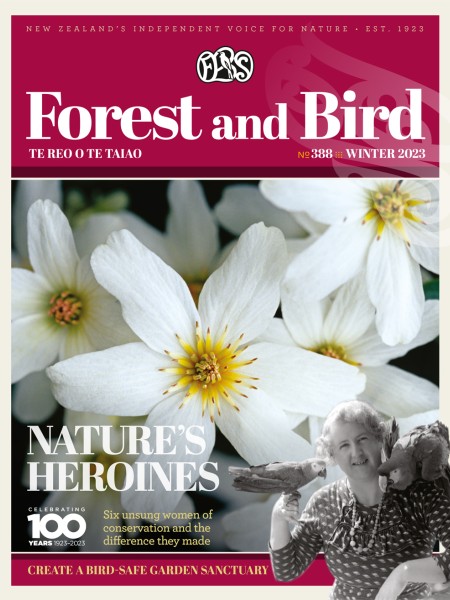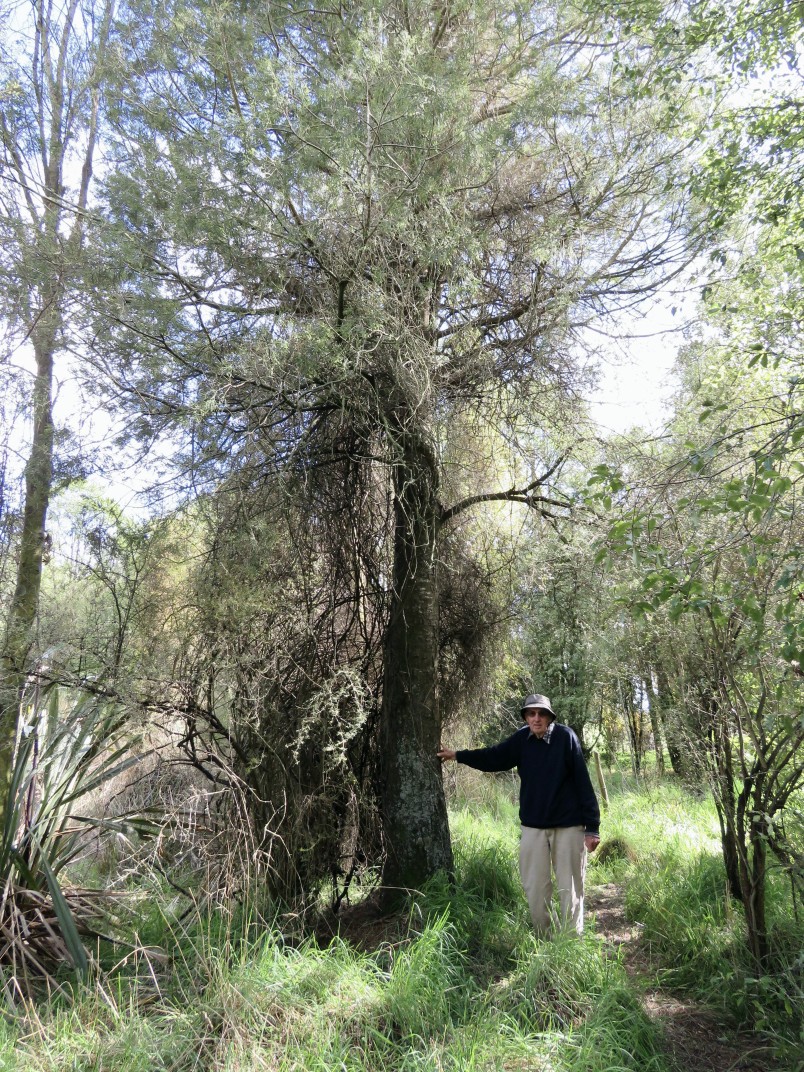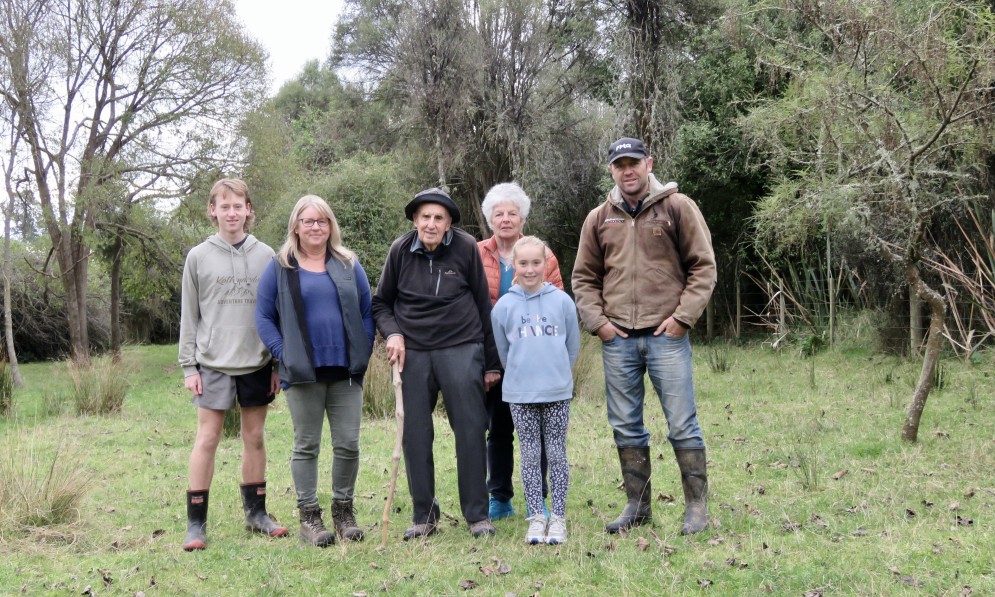In a nearly 50-year labour of love, Forest & Bird branch members saved an important stand of indigenous bush in South Canterbury. By Lynley Hargreaves
The last remnant of tall forest left on the lower plains of South Canterbury was recently secured for future generations, thanks to generous locals who helped Forest & Bird buy Arowhenua Bush.
Forest & Bird magazine
A version of this story was first published in the Winter 2023 issue of Forest & Bird magazine.

South Canterbury Branch members Fraser Ross and Robert Birks made significant gifts towards the nearly $400,000 total cost of the land, near Temuka, with two other donors asking to remain anonymous.
Fraser, 89, has been looking after Arowhenua Bush for nearly 50 years. He says it looked more like a battlefield when he first set eyes on it following a huge 1975 storm that knocked over many of its mature trees.
With permission of the then landowners, the Lyon family of Arowhenua Station, he started collecting seeds, propagating them, and planting them back out in the bush. A restoration project evolved from there.
Since 1975, all the seeds and cuttings have been eco-sourced from a 5km radius of the bush – so the genetic material remains true to the original plant lineage.

Pōkākā (Elaeocarpus hookerianus) at Arowhenua. Image Ines Stäger
Trees in the remnant podocarp-hardwood forest include kahikatea, kōwhai, matai, and weeping matipo. There are also several pōkākā, a small native tree with beautiful flowers.
“I was told that I would never get trees to grow there because of rabbits and hares,” says Fraser.
“That proved to be the case – it was a major obstacle – but we overcame that by putting guards around each individual tree, and they started to grow.”
Now those trees are up to 10m high, with some fully grown, and the bush and its wetlands have been designated a Significant Natural Area by Timaru District Council. A rare species of New Zealand swamp nettle, Urtica perconfusa, occurs in the wetland.
“Fraser basically saved this block of land,” adds Robert Birks. “In most cases, someone would have just piled up the remains and burned them.”
Fraser, who has visited the bush block more than 800 times at last count (five years ago!), paid tribute to the many locals who have helped him with restoration planting since the 1970s, mostly from Forest & Bird’s South Canterbury Branch.
The chance to secure the site forever came three years ago, when the station’s new owners Stu and Kate Bowman approached Forest & Bird and offered to sell the bush block.
The Bowmans, who have been carrying out long-term pest management of the area, are very supportive of Fraser and his team’s work, and plan to stay involved helping look after the bush.
“We’ve taken possum numbers down by at least 75% since we got here, down from several hundred when we first started,” says Stu.
“This project wouldn’t have happened without Fraser. I really admire his commitment to it over such a long period of time.”
Landscape architect Ines Stäger, who is a long-serving South Canterbury Branch member, has spent many hours helping secure Arowhenua Bush for future generations.
“This has been a huge project for a small branch, with people giving their time and money, and we are very grateful for their generosity and foresight,” says Ines.
“Just one percent of natural vegetation on the lower South Canterbury plains remains. As such, it was vital to secure the highest possible protection for its future.”
The restoration project would not have been possible without a local couple (who wish to remain anonymous), who were inspired to contribute because of its historic value.
“We have a long-held interest in the pre-European landscape of South Canterbury and knew Arowhenua Bush was one of the last remnants,” they said.
“We also knew that Forest & Bird would probably never get this opportunity again, so it was vitally important, and we wanted to help.”
The branch will now work with regional manager Nicky Snoyink on the site’s ongoing protection, including setting up a management committee to establish a restoration plan.

Fraser Ross at Arowhenua Bush in 2015. Image Ines Stäger
LOCAL LANDMARK
Arowhenua Bush is a small remnant of one of the very few areas of podocarp-hardwood forest present on the lower plains of South Canterbury at the time of European settlement.
In 1849, the surveyor Charles Torlesse described what he called “Horowenua” as a “wood of 500 acres [200ha] and as the only area of forest away from the foothills”.
Arowhenua Bush was a prominent landmark used to guide coastal steamers on their approach to Timaru. It appears the closest remnant of this type of forest was (and still is) Riccarton Bush in Christchurch.
Devastating fires in January 1863 reduced the extent of Arowhenua Bush substantially. Then, in 1975, westerly gales caused severe damage, blowing down many of the remaining trees.
A visit to Arowhenua Bush by Fraser Ross and Colin Burrows in 1977 resulted in a description of the forest remnant and recommendations for management.
Since that time, Fraser Ross has been closely involved in the protection and restoration of Arowhenua Bush, with the support of the Lyon family, spending many hundreds of hours weeding, planting, and caring for the forest remnant.
Source: Timaru District Significant Natural Areas Survey, Arowhenua Station, prepared for Timaru District Council by Mike Harding, February 2008.

